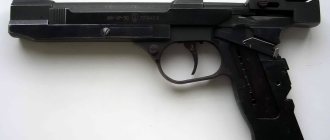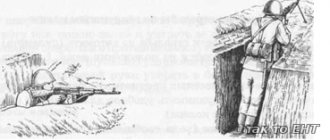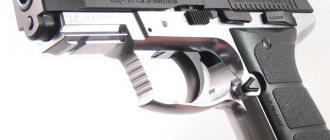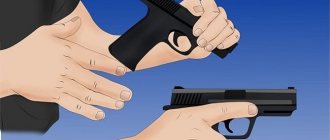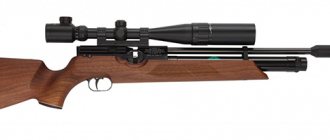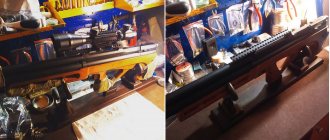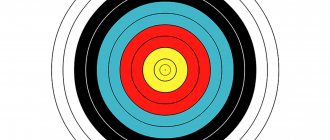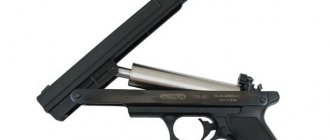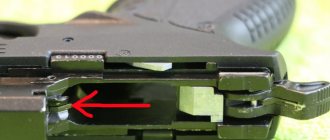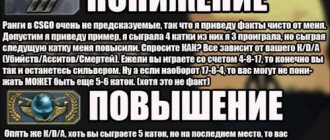Home | Weapons | Shooting training | Proper pistol shooting
Since its inception, the pistol has become the most accessible and popular fire weapon for self-defense and offense. Proper pistol shooting includes following the rules of safe handling of weapons and behavior at shooting ranges and shooting ranges, practical shooting classes that will help you learn the correct stance, grip, aiming and shooting. You can master this art in sports sections.
Shooting from a pistol.
Basic Gun Safety Rules
When handling any firearm, the following basic rules must be strictly observed:
- The weapon is considered always loaded until it is possible to verify the opposite personally.
- You should always hold the weapon in the safest direction - the barrel should only be pointed at the target you are going to shoot at.
- The index finger should be outside the trigger guard. Exception: when the shooter looks at the target through the sighting device.
- Before you pick up a weapon, you need to study its technical characteristics and features.
- The weapon must be stored in a safe place that will prevent its unauthorized use by others. Weapons and ammunition are stored separately.
- Only pick up a weapon when sober.
Following these simple rules will help you avoid accidents that can result in injury or even death when handling firearms.
How to correctly decipher the image of a pistol in a dream?
So, there are several interpretations of a dream about a gun. Moreover, some interpretations contradict others. How to find among them the one that suits each specific dream? In order not to be mistaken in the interpretation of sleep, it is enough to adhere to the following plan:
- When you wake up , write down all the memorable details of your night dreams. This must be done immediately after waking up, since during the day the dream will be forgotten;
- Remember how you felt and what you were thinking about before going to bed. This will help determine the meaning of the gun image;
- Consider your own fears and phobias, especially if you suffer from a fear of firearms;
- Study materials from several dream books and choose the appropriate interpretation of the dream about a gun.
Important! To fully analyze a dream, it is necessary to study not only the leading image, but also all the accompanying ones. Using dream books, study other symbols that appear in night vision. For example, if you dreamed about a policeman, find out what it means when a policeman appears with a gun in your dream. This is the only way you will get a complete picture of the dreamed plot.
Share with your friends!
more
Read us in the Zen channel
Rules at shooting ranges and shooting galleries
While at shooting ranges and shooting ranges you must:
- Perform all actions only at the command of the instructor.
- Do not carry a loaded weapon or leave it in the line of fire.
- Do not point the weapon at those present, to the sides or to the rear.
- Do not hold the pistol in the line of fire with the barrel down or up at an angle of 60°C.
- Do not move further than 1 meter from the weapon.
- To avoid strong ricochet, do not shoot at targets with deep dents.
- Shooters and spectators should protect their eyes and ears with glasses, headphones, and earplugs.
Shooting from a pistol at a shooting range.
Shootout
Hearing the sounds of shooting in a dream is a sign foreshadowing major family quarrels and scandals. Escaping from a firefight is a good sign, especially if you managed to hide from bullets; it portends a successful solution to complex cases with minimal costs.
To take part in a shootout yourself - such a dream means that in reality there is a risk of being drawn into an unnecessary conflict and it will bring nothing but harm. To be wounded or killed in a shootout means to suffer innocently or become a victim of someone else's squabbles.
If someone close to you was injured in a shootout, then such a dream predicts losses, damages and waste. If you started a shootout, this means that an incident will happen in the near future that will greatly “cool down” your ambitions.
Tactical shooting
Tactical shooting is the main element of combat training. During it, the main task is not only to hit the target, but also to protect yourself from enemy fire.
Correct stance
Proper stance is an essential part of a shooter's success. There are 8 most popular shooting stances:
- The basic stance is where all beginners start. For such a stance, it is only important that the barrel of the pistol faces the target.
- Frontal stance - legs shoulder-width apart, in line and slightly bent, arms almost completely straightened at the elbows and form an isosceles triangle with the body. The gun is centered at eye level.
- Tactical or combat stance - differs from the frontal one only in that the leg on the side of the supporting hand is moved forward by half the length of the foot. This gives more stability when firing high-power ammunition.
- Weaver shooting stance. The strong arm is slightly bent at the elbow and holds the handle of the pistol. The weak hand clasps the hand of the strong one, its elbow is strongly bent and looks down. The leg on the side of the weak arm is slightly bent at the knee and brought forward. The leg on the side of the strong arm is straight, set back, the foot is turned 45°C. The body is slightly tilted towards the target.
- Chapman's shooting stance differs from Weaver's in that the supporting leg is not extended far, and the shoulder of the weak hand is not turned towards the pistol.
- Center Axis Relock Rack. The weak leg is in front, and all the emphasis is on the strong leg. The strong arm is half extended and raised. The weak arm is bent and the elbow is pointing down. Both wrists are straight. The sight is at the level of one of the eyes. The rear sight of the pistol is 30-40 cm from the eyes and tilted 20-45°N towards the weak hand.
- One-handed shooting stance. Reminiscent of a boxer's stance before a decisive blow. The pistol is grasped with one hand, with the other pressed to the chest. The leg on the side of the hand holding the weapon is moved forward 30-50 cm. The knees are slightly bent.
- A stand for self-defense with holding the weapon against the body. The hand with the pistol is fixed with the elbow and pressed to the body. The other hand is at shoulder height or pressed to the chest to avoid being shot. This stance is used during a short range threat. When faced with a threat at medium and long distances, it is easy to transition from it to any of the stances listed above.
Pistol shooting stand.
Grab the weapon
The grip of the weapon affects shooting accuracy, and the correct grip helps reduce recoil. The position of the fingers of the hand holding the pistol should be as follows:
- The thumb and index finger are parallel to the axis of the barrel bore on different sides of the handle, but at the same height.
- The palm rests tightly and widely on the handle without sagging or voids.
- The middle joints of the little, ring and middle fingers are located perpendicular to the bore, and their back side is directed towards the target.
- The first phalanx of the index (pressure) finger lies on the trigger needle at a right angle.
When shooting with two hands, the second hand can hold the shooting hand from below or from below and in front.
Another important point: you need to hold the gun as tightly as physically possible, but so that there is no hand tremors from overexertion.
Aiming and Shooting
In contrast to the fact that you need to focus on the target, it is better to aim and shoot with both eyes open. This way, aiming is faster and your eyes are less tired.
While aiming, the shooter may associate himself with a stationary metal or concrete structure, and stationary muscles with lake water in calm weather. But a more accurate shot can be made with dynamic aiming. In this case, the shooter brings the weapon to the center of the target and fires a shot after 1-3 seconds.
You need to pull the trigger as slowly and gently as possible. After pressing, you do not need to immediately remove your finger from the trigger and run to look at the target, so as not to cause additional unnecessary vibrations of the weapon.
Correct aiming at the target.
Shooting from a pistol is not the same as hitting a target located several kilometers away with a sniper rifle, so there is no need to hold your breath. The more natural your breathing is, the less likely it is to be interrupted after the shot.
Additional information about the methodology
The first practice at the shooting range does not produce the expected results only because the shooter does not have sufficient muscle memory. As a result, fear may occur in the form of flinching, as a reaction to a shot.
To prevent this from happening, you should spend enough time dry training. It consists of firing blank cartridges before switching to live ones.
You should also start from short distances to reduce the influence of extraneous factors that affect shooting accuracy (wind, type of ammunition).
A trick to help overcome the fear of being shot is to have a friend mix blank and live cartridges in secret from the shooter. This will help you know the actual reaction to the shot and how well the shooter handles recoil.
Part 1: Basic knowledge needed to shoot a pistol
Learn the difference between a revolver and a semi-automatic pistol
There are two main types of pistols - semi-automatic pistols and revolvers. Something you often saw in cowboy movies were revolvers. The cartridges in the revolver are loaded into a drum located in the middle of the body. It typically holds six rounds, but some hold five and fit comfortably in smaller hands. A semi-automatic pistol has a sliding mechanism (breech) at the top and a magazine in the handle.
Each type of gun operates a little differently, so it's important to be clear about what you'll be dealing with before you go to the range and learn how to handle the gun.
- The revolver has a rotating drum for ammunition. The cartridge is loaded into it, then the drum is inserted back into the revolver. After this, you can already shoot from a pistol of this type. After the bullet is fired, the drum rotates and thus the next cartridge aligns with the barrel and hammer, and the used one moves further. Most revolvers operate in a double-action mode: pulling the trigger cocks the hammer until it drops and fires. This operating mechanism forces the shooter to put more effort into firing a shot, however, the hammer can also be cocked manually - before pressing the trigger. The cylinder is then snapped out (or the revolver is broken, exposing the cylinder), allowing the empty cartridges to be removed.
- A semi-automatic pistol forces each round into the chamber from the magazine. After firing, he ejects the empty cartridge through a special hole - the ejection window. The bolt on top of the pistol is used to load the first round into the chamber and can be locked in the open position using a button or pin on the side. The magazine is removed and charged separately, which is why it is called removable.
Choose the right pistol and ammo for shooting
There are different types of pistols, and if you count the combinations of “pistol - type of ammunition”, you get just an infinite number. In addition, when choosing a weapon and ammunition, take into account your physiological parameters (physique, hand size, etc.) and the purpose of the pistol.
- You don't need a .357 Magnum to simply learn how to shoot a pistol at targets at standard pistol range. Don't buy guns that are too large or have a large caliber if you are just starting to learn how to shoot. Instead, spend your money on something small but reliable. For example, a .22 caliber pistol would be a good choice. Talk to a dealer or someone who already has experience in choosing and using a gun. Such people will be happy to share their experience and give important recommendations.
Wear eye and ear protection
Headphones combined with good earplugs will protect your ears from loud gunshots. Special shooting glasses will protect your eyes from cartridge fragments, hot gases and empty cartridges that constantly fly out of a semi-automatic pistol.
- Do not think that ordinary glasses are suitable for this task. Even if you already wear them, be sure to also wear protective ones. They are called “protective” because they protect your eyes so well that simple ones simply cannot do.
Always follow safety rules when handling a pistol
When handling the gun, always keep it pointed downwards. Do not use weapons in places where there is no special equipment for shooting, an equipped bullet catcher and personal protective equipment specified in the previous paragraph.
- Be careful and follow all safety precautions while at the shooting range. It's not just important to follow range safety rules, you also need to be aware of what the people around you are doing. This is called situational awareness.
- It is not easy for a beginner to operate the shutter using only the thumb and forefinger (as is usually done by the pros). The situation gets worse when the gun has a tight spring or when the shooter's hands become sweaty. If you need to use your entire palm to pull the bolt, lower the pistol, turn slightly sideways and, with the barrel facing away from you, move the weapon slightly away from your body.
Practical shooting and live shooting
Practical shooting is a type of shooting sport in which all exercises imitate a combat situation as much as possible. At the same time, the use of practical shooting techniques in combat conditions is a sure path to suicide.
The goal of combat shooting is to save your life and complete the combat mission. The goal of practical shooting is to score the most points for accuracy.
Combat shooting from a pistol.
Practical shooting competitions are held in stationary and well-lit halls. In combat you have to shoot in difficult weather and landscape conditions, in the dark, with temporary loss of vision or blindly. Also, during combat shooting, the shooter’s stance is not regulated; the target is not static, but moving and posing a threat.
How to position your elbows and hands
There is no consensus on this issue either. Some hunters believe that elbows need to be raised high enough when shooting. Others find that it is better to keep them in a natural position and spread their forearms slightly to the sides. Most choose the second method. High elbows also help with skeet shooting. They create a strong lock between the cheek and butt. During normal hunting, movements become constrained, and the shooter can miss even from an advantageous position from a short distance.
The hands of both hands should be positioned as comfortably as possible. This will allow you to easily control the weapon when selecting a target.
Errors when aiming the sight
Unnecessary movements and excessive tension when aiming a weapon increase the aiming time and worsen the quality of shooting. The main common mistakes when aiming a sight include:
- Tense and raised shoulders. This hinders movement and quickly tires the shooter.
- Lowered, bent elbows when pointing the weapon at the target. This way the gun “lifts up” more during recoil, increasing the time it takes to fire again.
- Head tilted towards a strong hand, as when shooting a gun. At the same time, the field of vision shifts and the neck muscles become overstrained.
- Moving your head while aiming is a mistake for novice shooters. This increases the aiming time - only your hands should work.
- Raising the barrel when pointing the pistol at a target. Reminds me of casting a fishing rod. With this movement, the pistol covers the target for some time, which increases the aiming time.
- Lowering the pistol when pointing it at the target. In this case, the weapon suddenly appears in the line of fire, after which additional time is needed to align the sights.
You can learn to shoot a pistol by doing sports or practical shooting (depending on the tasks). Live shooting for civilians is only available with traumatic weapons for self-defense purposes.
Shooting training
- Pistol shooting basics. Introduction.
- Types of pistol shooting
- Interesting moments when shooting a pistol.
- Actions when shooting a pistol
- Handling the Pistol Safely
- Proper pistol shooting
- Pistol shooting training
- How do small arms work?
- The device of cartridges
- Bag for concealed carrying of weapons. Case-holster QUIVER.
- Training marker gun TsNIITOCHMASH
How to properly distribute muscle effort
The secret here is simple. The hand that holds the fore-end must be pushed forward as far as possible, while the hand gripping the butt must be pulled back at the same time. With this grip, some tension is created, the shooter perceives less recoil and returns the barrel to the target faster. Shooting masters advise straining one of your hands less. When hunting, the leader is advised to leave the front hand. It becomes the main one when aiming at game.
Some hunters prefer to raise the gun with both hands in unison and point it at the target at the same time. This way they save time for shooting.
The position and work of the hands during shooting is largely an individual matter. But all experts agree on one thing: it is imperative to control the compression force of the gun. If the fore-end slips in your hand during a shot, then your grip should be strengthened. If your fingers turn white and numb from tension, then you need to loosen it.
Some hunters change the position of their hands from time to time. This helps them get the gun on target faster. The classic grip among shooters is the middle grip of the forend. But many keep their hand closer to the box. Placing it completely on the rear of the forend is risky. The hand is too tense, so it’s easy to miss the target. The gun is held by the front part of the fore-end only if it is too short.
In the wrong hands
If you dreamed of another person holding a gun, the interpretation of the dream book differs. If no negative emotions were experienced in the dream, nothing bad should be expected. On the contrary, a loved one will help in difficult times. If at the same time there is fear in the dream, you should be wary of the betrayal of a blood person.
Seeing a gun in the hands of a stranger in a dream promises good acquaintances and care from loved ones. If there is a fear of being killed, an unkind person will try to ruin life. Perhaps even a group of people is preparing some kind of trouble for the dreamer.
If you dreamed of a policeman holding a gun in his hands, this indicates a feeling of pressure from management or superior people. Other dream books interpret such a dream as the dreamer’s desire to shift all his problems onto the shoulders of a stronger person.
A dream in which the dreamer saw a maniac with a pistol in his hands carries a negative meaning. What you see promises to find you in a difficult and dangerous situation. In the near future, you will need to be careful; this is the only way to avoid the unpleasant consequences of such a dream.
